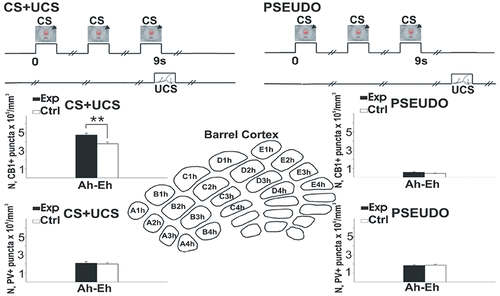当前位置:
X-MOL 学术
›
ACS Chem. Neurosci.
›
论文详情
Our official English website, www.x-mol.net, welcomes your
feedback! (Note: you will need to create a separate account there.)
CB1 Cannabinoid Receptor Expression in the Barrel Field Region Is Associated with Mouse Learning
ACS Chemical Neuroscience ( IF 4.1 ) Pub Date : 2018-03-14 00:00:00 , DOI: 10.1021/acschemneuro.7b00500 Ewa Siucinska 1 , Wojciech Brutkowski 2 , Tytus Bernas 2
ACS Chemical Neuroscience ( IF 4.1 ) Pub Date : 2018-03-14 00:00:00 , DOI: 10.1021/acschemneuro.7b00500 Ewa Siucinska 1 , Wojciech Brutkowski 2 , Tytus Bernas 2
Affiliation

|
We found previously that fear conditioning by combined stimulation of a row B facial vibrissae (conditioned stimulus, CS) with a tail shock (unconditioned stimulus, UCS) leads to expansion of the cortical representation of the “trained” row, labeled with 2-deoxyglucose (2DG), in the layer IIIb/IV of the adult mouse the primary somatosensory cortex (S1) 24 h later. We have observed that these learning-dependent plastic changes are manifested by increased expression of somatostatin, cholecystokinin (SST+, CCK+) but not parvalbumin (PV+) immunopositive interneurons We have expanded this research and quantified a numerical value of CB1-expressing and PV-expressing GABAergic axon terminals (CB1+ and PV+ immunopositive puncta) that innervate different segments of postsynaptic cells in the barrel hollows of S1 cortex. We used 3D microscopy to identify the CB+ and PV+ puncta in the barrel cortex “trained” and the control hemispheres CS+UCS group and in controls: Pseudoconditioned, CS-only, UCS-only, and naive animals. We have identified that (i) the association between whisker-shock “trained” barrel B hollows and CB1+, but not PV+ puncta expression remained significant after Bonferroni correction, (ii) CS+UCS has had a significant increasing effect on expression of CB1+ but not PV+ puncta in barrel cortex “trained” hemisphere, and (iii) the pseudoconditioning had a significant decreasing effect on expression of CB1+, but not on PV+ puncta in barrel cortex, both trained and untrained hemispheres. It is correlated to disturbing behaviors. The results suggest that CB1+ puncta regulation is specifically linked with mechanisms leading to learning-dependent plasticity in S1 cortex.
中文翻译:

桶字段区域中的CB1大麻素受体表达与小鼠学习相关。
我们以前发现,通过联合刺激B行面部触毛(条件刺激,CS)和尾巴电击(无条件刺激,UCS)来进行恐惧调节,会导致“训练过的”行的皮质表示扩展,并标记有2-脱氧葡萄糖(2DG),在24小时后,在成年小鼠的IIIb / IV层中建立主要的体感皮层(S1)。我们已经观察到,这些学习依赖的塑性变化表现为生长抑素,胆囊收缩素(SST +,CCK +)的表达增加,但不存在小白蛋白(PV +)免疫阳性的中间神经元。我们扩大了这项研究并量化了表达CB1和PV表达的数值GABA能轴突末端(CB1 +和PV +免疫阳性点)支配S1皮质桶状凹陷中突触后细胞的不同区段。我们使用3D显微镜在“训练过的”桶状皮层和对照半球CS + UCS组以及对照中鉴定了CB +和PV +点,这些动物是伪条件动物,仅CS,仅UCS和天真动物。我们已经发现,(i)在Bonferroni校正后,“晶须电击”训练过的“ B桶”空洞和CB1 +之间的关联仍然显着,但(PV)点状表达没有显着影响;(ii)CS + UCS对CB1 +的表达具有显着增加的作用, (iii)假条件对训练过的半球和未经训练的半球的CB1 +表达均具有显着的降低作用,但对桶状皮质的PV +点却没有显着的影响。它与令人不安的行为有关。
更新日期:2018-03-14
中文翻译:

桶字段区域中的CB1大麻素受体表达与小鼠学习相关。
我们以前发现,通过联合刺激B行面部触毛(条件刺激,CS)和尾巴电击(无条件刺激,UCS)来进行恐惧调节,会导致“训练过的”行的皮质表示扩展,并标记有2-脱氧葡萄糖(2DG),在24小时后,在成年小鼠的IIIb / IV层中建立主要的体感皮层(S1)。我们已经观察到,这些学习依赖的塑性变化表现为生长抑素,胆囊收缩素(SST +,CCK +)的表达增加,但不存在小白蛋白(PV +)免疫阳性的中间神经元。我们扩大了这项研究并量化了表达CB1和PV表达的数值GABA能轴突末端(CB1 +和PV +免疫阳性点)支配S1皮质桶状凹陷中突触后细胞的不同区段。我们使用3D显微镜在“训练过的”桶状皮层和对照半球CS + UCS组以及对照中鉴定了CB +和PV +点,这些动物是伪条件动物,仅CS,仅UCS和天真动物。我们已经发现,(i)在Bonferroni校正后,“晶须电击”训练过的“ B桶”空洞和CB1 +之间的关联仍然显着,但(PV)点状表达没有显着影响;(ii)CS + UCS对CB1 +的表达具有显着增加的作用, (iii)假条件对训练过的半球和未经训练的半球的CB1 +表达均具有显着的降低作用,但对桶状皮质的PV +点却没有显着的影响。它与令人不安的行为有关。











































 京公网安备 11010802027423号
京公网安备 11010802027423号